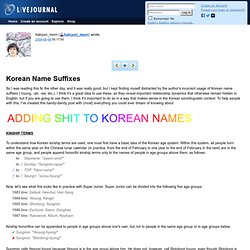

Introduction to Korean. This tutorial requires a browser that complies with the standards established by the World Wide Web consortium.

Unfortunately, your browser is not one of them. If you wish to upgrade your browser, here are some suggestions. If you want to continue using your current browser (or are required to by your workplace or place of study), you may wish to go to the older version of this tutorial. Choose a topic: <hr /><p><b><span class="bigger attention">Note: these pages depend heavily on Javascript in order to function properly. 네이버 영어사전 (Naver English Dictionary) Sogang Korean Program. Adding Shit to Korean Names. So I was reading this fic the other day, and it was really good, but I kept finding myself distracted by the author's incorrect usage of Korean name suffixes (-hyung, -ah, -ssi, etc.).

I think it's a great idea to use these, as they reveal important relationship dynamics that otherwise remain hidden in English, but if you are going to use them, I think it's important to do so in a way that makes sense in the Korean sociolinguistic context. To help people with this, I've created this handy-dandy post with (most) everything you could ever dream of knowing about To understand how Korean kinship terms are used, one must first have a basic idea of the Korean age system. Within this system, all people born within the same year on the Chinese lunar calendar (in practice, from the end of February in one year to the end of February in the next) are in the same age group, and people append honorific kinship terms only to the names of people in age groups above them, as follows: